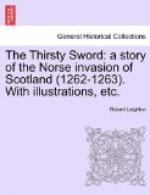In another hour thereafter, Roderic, having left the castle in charge of one of his captains and a full garrison of men, entered his ship and with his other galleys sailed away on his expedition of plunder on the banks of the Clyde.
Being joined by other ships from Kintyre, Islay, and Jura, together with the forces of Margad who had invaded and conquered the isle of Arran, his armament now numbered sixty galleys. They took the castles of Dunoon and Roseneath, and laid waste many villages and farmsteads. Farther still they went, up the waters of Loch Long, devastating the lands on either side. At the head of Loch Long they took their smaller ships and mounting them on rollers made of the trunks of larch trees, they dragged the vessels bodily over the neck of land that lies between Arrochar and Tarbet, and launched them on the great lake that is called Loch Lomond.
Now on Loch Lomond there are many small islands that were at that time thickly peopled, and many Scots of the invaded earldom of Lennox had taken refuge on those islands when they heard that the Norsemen were advancing. Their safeholds now became the scenes of plunder and bloodshed, the islands were wasted with fire, the shores of the beautiful lake were completely ravaged, and the houses on its borders burnt to the ground.
After this, Roderic and Magnus made an extended expedition into the rich county of Stirling, in which they massacred great numbers of inhabitants, and returned driving herds of cattle before them, and loaded with booty.
During his voyage up the Clyde, Roderic had paid little heed to the fair captive Aasta. But when, triumphant and gloating, he returned to the ships he had left in Loch Long, he discovered that his prisoner had escaped, and he was very wrathful, for, as he said, the maid was passing fair, and he had been minded to take her back with him to his castle. But no man could tell him how the girl had escaped, or which way she had fled.
Roderic, having filled his ships with plunder, then set out for Kintyre, where he was to join King Hakon. But entering the Clyde from Loch Long, he encountered a terrible storm. Ten of his vessels were completely wrecked, and his own galley was forced to steer clear of Bute, and take refuge behind the islands of Cumbrae.
The measure of the Norwegian success was now full. Hakon had gained possession of every island, great and small, on the west of Scotland. In the far north he had established his footing not only in the Shetlands and Orkneys, but he had made himself master of the whole county of Caithness. In the south, Kintyre had been unconditionally ceded to him by its timid lord. Bute, Arran, and the Cumbraes had been conquered; the rich county of Lennox — one of the most fruitful in Scotland — had been laid waste, and on the outer coasts of the mainland the Norsemen had planted their banner on many a well-built castle. Hakon was now intent upon conquering Scotland, so, gathering his whole fleet of nearly two hundred ships, he sailed from Gigha round the Mull of Kintyre, and anchored in Kilbrannan Sound.




